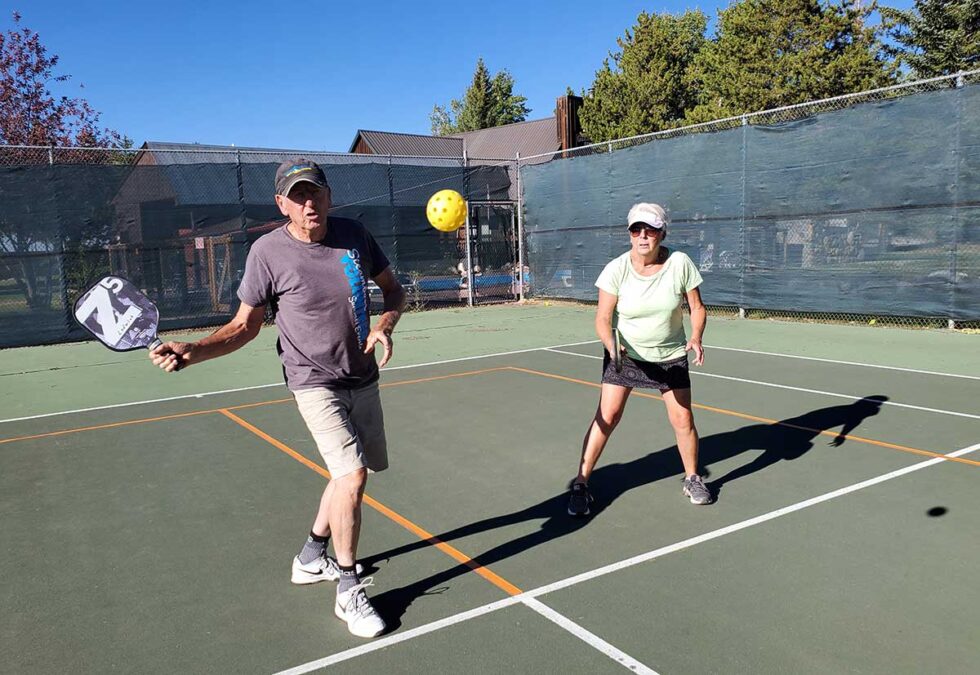Another type of technology changes lives
In North Routt County, Clark residents Jeanne and Dennis Lodwick are shooing their dog away from a visitor. The duo move around briskly, cracking jokes at each other like an old couple in a comedy TV sitcom.

Jeanne got a new hip just three months ago and is back playing pickleball and paddleboarding. Meininger’s partner, Dr. Andreas Sauerbrey, operated on Jeanne’s hip and also put in Dennis’ new titanium knee two years ago.
But it was another technological advance that changed the Lodwicks’ lives dramatically.
“It was the most amazing medical miracle I’ve ever seen in my life,” said 74-year-old Jeanne.
She is talking about her husband’s neurostimulator, a sort of pacemaker for the brain.
About 15 years ago, doctors diagnosed Dennis with Parkinson’s Disease, a brain disorder that leads to shaking, stiffness, difficulty walking and bad balance and coordination. By 2016, the Lodwicks’ quality of life had plummeted.
“I couldn’t hold a glass of wine. I literally had to sit on my hands to keep from shaking,” Dennis said.
The two couldn’t go out in public, because his intense shaking could lead to accidents. The couple even stopped their yearly driving vacations. Then about four years ago, neurologist Dr. Mihaela Alexander gave a talk about advancements in treatment for Parkinson’s patients at the Bud Werner Memorial Library in Steamboat.
After hearing about the procedure called deep brain stimulation, the couple made Dennis an appointment with the Denver-based neurologist.
He endured a battery of mental and physical tests before he got the go-ahead to proceed with the innovative procedure.
As the couple scrolled through cellphone photos of all their surgeries, from old bones taken out of Dennis’ knee, to an X-ray of Jeanne’s new metal joint, Dennis tried to paint a picture of how the neurosurgeon proceeded.
“They basically bolt a robot to your head that helps guide the surgeon,” he said.
Dennis’ hair covers the two large scars where the surgeon implanted the stimulators on each side of his head with probes aimed at a specific site on the brain. Two weeks after they put in the stimulators, they put batteries on each side of his chest and ran wires to the stimulators in his head. Then after two more weeks of healing, the neurosurgeon dialed in the amount of electrical stimulation they’d send to Dennis’ brain probes.
“It was unbelievable, truly a medical miracle,” said Jeanne remembering the first time the neurosurgeon turned on the neurostimulators in Dennis’ brain. “He went from shaking all over to nothing. I told the doctor, ‘that’s a really good trick. Let’s do it again.
“We bought five years of quality life so far. I wouldn’t have been able to take care of him without it,” Jeanne added.
Dennis brought out his small hand-held programming unit to show us how many volts were going to each side of his brain. The part of the brain that controlled the left side of his body showed 2.7 volts, while 3.8 volts was used to control the right side of his body.
“My wife keeps joking she’ll turn it off if I upset her,” Dennis joked.
Although Dr. Alexander was unavailable to expound on Dennis’ treatment, Dr. Drew Kern, a movement disorders neurologist at UCHealth and the University of Colorado, urged people with movement disorders like Parkinson’s, epilepsy, dystonia and essential tremor to seek out a full array of medical help.
“Deep brain stimulation is one of many advanced treatments available for patients with movement disorders,” Kern said. “At UCHealth, we have a team approach alongside our patients to determine the best therapeutic approach … neurologists, neurosurgeons, physical medicine, rehabilitation physicians, therapists.”
He said patient-centered decisions allow people to live as active a lifestyle as possible.
As for the Lodwicks, Vanda Nohinek and Marcia Pomietlasz, they couldn’t agree more and they said it all starts with research.
“Always get a second opinion,” said Jeanne. “Any surgery is an important and difficult surgery. Give it a lot of thought, pick your doctor carefully.
“And have a positive attitude and expect the best results,” Dennis.
Pomietlasz can’t imagine that any active senior would think twice about joint replacement.
“If you’re happy not doing the things you did before, maybe it’s not for you,” she said.
“There’s nothing to be scared of,” added Nohinek, who moves nothing like an 89-year-old matriarch. “Go see your doctor, and if you’re a candidate for joint replacement, just go for it.”
Frances Hohl is a contributing writer for Steamboat Pilot & Today.
